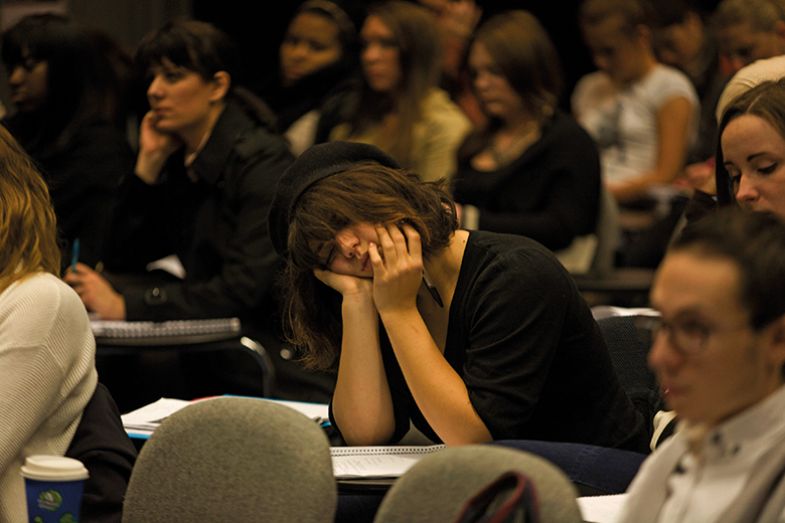‘My early career anxiety to cover as much as possible often led to students’ feeling overloaded’
It was when the student told me that my cardigan was on inside out that I knew that all my planning was a lost cause.
It was one of those occasions, early in my academic career at Birkbeck, University of London, when preparing for a class turned into a living anxiety dream. On this occasion, I had been asked to give a guest lecture to 150 first-year English undergraduates on performing Shakespeare – a topic I knew little about. Being new and anxious, I vastly over-prepared but never quite managed to finish writing the lecture.
That day, all three photocopiers broke down, which meant using the “spare” one that chugged 170 handouts out at a Sisyphean pace. While it did so, I searched frantically for the key to open the AV cabinet, which I had somehow mislaid in my race around the building looking for working copiers. Arriving at the lecture theatre as the students began to filter in, I discovered an incomprehensible AV system with no evident on switch. This necessitated another race to the front desk to plead for help. Finally, as I ran back into the room drenched in sweat, I was stopped by a student midway down the aisle. I turned to her in relief, thinking she might know how the technology worked, only for her to tell me – kindly – about my cardigan.
Inevitably, of course, the students responded to my incompetence with great enthusiasm. The fact that I had only managed to finish writing up about three-quarters of the lecture required me to build “thinking time” into it. This allowed them to catch up with the material as we covered it, and asking them to have short discussions with their neighbours meant that they didn’t remain passive recipients of the information, but had the chance to process the ideas as they emerged. A graduate teaching assistant told me afterwards that the students felt that it had been one of the best lectures of the year.

Little did they know what it had cost my nervous system. But, of course, they were right. This is one of those stories in which failure becomes a salutary lesson.
My early career anxiety to cover as much as possible often led to students’ feeling overloaded, unable to process the material or grasp why it mattered. A lecture that left them space to engage, to reflect, to think, covered far less but engaged them more, meaning that they actually learned something.
I realised that lectures didn’t need to look like they do in the movies, where an old man in tweed – or a young, dynamic man in a leather jacket – holds students captivated via the expression of their charismatic genius. Rather, lectures could work like really big seminars or workshops. An entire cohort of students could gain an identity as a “year group” by learning communally, sometimes listening in silence (which is a useful skill in itself), sometimes writing alone, sometimes working together. Lectures, it turned out, were not about how much I knew, but about how much they learned.
Now lecturing is one of my favourite forms of teaching, not least for how much it’s possible to subvert the format, to surprise the students with what they can do in a big group. Now my lectures are three-quarters finished on purpose.
But I do check that my cardigan is on the right way round before starting. Some lessons are learned the hard way.
Aoife Monks is reader in drama, theatre and performance studies at Queen Mary University of London.
‘Turning off the lights is not a great idea’
When I was an undergraduate in the late 1980s, lectures were pretty much delivered by someone speaking at the podium for 80 minutes straight – with some instructors choosing to underscore some highlights with good old chalk on the board.
By the time I got to graduate school, the overhead transparency had emerged as the cool, cutting-edge technology. About a decade later, the computer projector showed up, and PowerPoint slideshows started to take over. Then came YouTube and TED talks.
In this context, multifaceted lectures have become all the buzz. Young instructors are often encouraged to intersperse their discourse with a combination of slides, videos and discussions, mirroring the multimodal calls on their attention to which digital natives are accustomed.
But I would like to offer two pieces of advice. First, don’t take yourself out of your lectures by over-relying on technology.
One not-so-great lecture that stands out in my mind was delivered by a young psychologist I was asked to peer-observe. Once all the students had entered, the instructor turned off the lights and turned on the projector. It was early in the morning and I wasn’t sure if I was ready for that. But even at the best of times, turning off the lights is not a great idea. It makes the slides more visible, but it takes you out of the teaching, minimising your opportunity to bring material to life.
It was never going to be the most thrilling lecture. The topic was a technical set of concepts related to higher-order conditioning. But 80 minutes of PowerPoint only deepened the agony. The slides were self-explanatory, so the instructor’s role was limited to hitting the projector’s “next” button. I caught myself nearly falling asleep a few times. Several students were snoring.

I later found that the slides were prepared by a textbook publisher. Such material should be thrown into the trash. As time-consuming as it may be, developing your own materials will bring you into the learning equation much more effectively.
And think about giving PowerPoint a rest. If chalk worked in my day, why shouldn’t it now? PowerPoint is overrated and over-utilised.
My second major piece of advice is not to leave any student behind.
I have been teaching classes in statistics since 1996. I enjoy the challenge of getting students who think that they won’t understand the material to master it. One semester, I had a unique student in my class. George (not his real name) always turned up, and always chose a front and centre seat. He was a pretty big guy, with a very loud voice. And zero impulse control. You couldn’t miss him.
In spite of being a little bit different, George was a bright young man, capable of understanding abstract concepts. But the second I said something that didn’t make complete sense to him, he’d shout out: “What does that mean?!” This occurred, I’d estimate, between five and 10 times each class.
As someone who always tries to teach with compassion, I made a point of acknowledging the bright side of George. My job is to get the students to understand the material. If George, a bright and hard-working student, didn’t understand some idea, my guess was that others in the room were probably also lost. I came to see George as the ultimate litmus test as to whether I was making sense.
That semester, the quality of my statistics teaching skyrocketed. Each lecture I would give, even on the most pedestrian content, suddenly became the best lecture I’d ever given! Shortly afterwards, I decided to write my own statistics textbook.
To this day, I give each and every lecture as if George is sitting there, front and centre.
Glenn Geher is professor of psychology at the State University of New York at New Paltz.
‘A lot of the techniques I use for my primary school outreach work just as well on my third-years’
My first teaching experiences were as a diving instructor. My tutees were paying for lessons that their lives literally depended on. During my PhD and postdoctoral positions, I also did a lot of outreach and public lectures, attended by people – particularly the children – who wanted to be there and learn.
So it was a bit of a shock to the system when, as a junior lecturer, I was first confronted with UK undergraduates. I suppose that I am naturally a minority in that I loved university so much that I went on to become an academic, but I still can’t fathom how some students paying £9,000 a year don’t bother to come to lectures – or, if they do come, play on their phones or fall asleep rather than listen.
The funny thing is that I can’t actually remember many of the lectures I attended at university. It was fairly rare for my teachers to do anything other than offer a monologue from the lectern. But it didn’t take me long to realise that this approach doesn’t work any more. Modern students have a shorter attention span than their predecessors, and expect to be entertained.
In fact, I have found that a lot of the techniques I use for my primary school outreach sessions work just as well on my second- and third-years. A favourite activity is actually taken from one of the rare memorable lectures I attended as an undergraduate. It involves asking everyone to stand in a row and pretend to be a seismic wave. Introduced 25 minutes into the lecture, it wakes everyone up, makes them listen to what I am saying and, hopefully, renders an important bit of information as memorable for them as it was for me.

Other options for fun half-time breaks include showing a video, unveiling a prop or getting the students to each write something on the board. But these are not enough if the rest of your lecturing is bereft of charisma.
I recently attended a meeting made up of several 45-minute lectures. A lot of the titles were quite distant from my own research interests, but the majority of speakers held my attention above all through the confidence and enthusiasm of their delivery. By contrast, I just couldn’t keep my eyes open through one presentation despite its interesting subject and powerful message. The speaker’s tone was monotonous and the material was presented without any invitation to the audience to think about it.
This latter point, I believe, is crucial. Above all, a good lecture must involve audience engagement. That could involve beginning with an explanation of why the lecture’s contents are important to the students. It could be maintained by a couple of well-placed and genuinely funny jokes, or exercises in audience participation. But, however you do it, a lecture needs to be a two-way interaction.
Yes, most of the information is going one way. But unless the audience is engaged in the conversation, you might as well be talking to yourself.
Jessica Johnson is a lecturer in solid Earth geophysics at the University of East Anglia.
‘Inducing students to work actively in lectures does not translate well to a crackly recording from a lapel microphone’
I have a terrible confession to make: I have a very short attention span. You know that 20-minute academic paper you gave at the conference we both attended? My mind wandered off for half of it.
So how students cope with two-hour lectures, I don’t know. And maybe they don’t cope. Certainly fewer of them are turning up. But the universality of poor attendance suggests that it is not the quality of lectures at fault.
Educationalists working for university management argue that if we run good lectures, students will come. But this seems to be based on outdated research that doesn’t recognise the pressures on current students. It also seems to play into the larger institutional habit of asking academics to internalise the university’s problems as their own personal-professional failures. Either way, if it is time to rethink the lecture – and maybe it is – it is not because lectures are inherently boring.
In fact, lectures can be pretty fun. I prepare my Australian history lectures for people like me, who have trouble focusing for long periods. As well as interspersing 15-minute segments with short video resources, I like to start each segment by interacting with the class, asking questions. These often need to be inventive: “If you were colonising the other side of the world, what would you need?” From food, equipment and labourers, we move to ideas – property, the rule of law. Before you know it, the bones of Australian settler-colonialism are ready for me to flesh out.

Later, I like to use a quiz tool like Kahoot, which students can access from their devices, to test what we have covered – or to get a picture of students’ assumptions. Each question is a springboard from which to explore tricky aspects of the topic. This breaks up the lecture and instils energy by making students more active. Plus, it is fun – albeit in a geeky way.
But all of this rests on two increasingly rare conditions. First, the students need to be in the room. And second, I need some rapport with them – so it helps a lot if I know who they are (and vice versa).
We are told that recording lectures is an entirely reasonable response to the fact that students face difficult lives. But if lecturers hate this development, it is not – contrary to nasty insinuations from managerial educationalists – because we are all narcissists desperate for an adoring audience. It is because inducing students to work actively in lectures – the approach the educationalists tell us will encourage them to turn up – does not translate well to a crackly recording from a lapel microphone.
Early in term, think-pair-share scaffolds can help break silences, but eventually I want students talking to the whole room. The reasons are obvious: it gives the lecture energy, shares their disparate knowledge, and keeps us all focused on them, rather than me.
Students’ need for relentless – and diversified – investment in their human capital is only getting bigger. Every year, they seem busier, more anxious, more desperate to find a productive pathway into the hyper-competitive graduate jobs market. More than ever, they need a supportive, collaborative and active place to learn. Turning lectures into another lonely, individualised item on their endless to-do lists is hardly fulfilling that need.
Hannah Forsyth is a senior lecturer in history at the Australian Catholic University.
‘Pedagogies styled on children’s TV are misleading and counter-productive’
Sesame Street has a lot to answer for. It is not coincidental that its Muppet-populated educational skits began to appear on American TV screens in 1969, the year of Woodstock. Ever since then, the traditional lecture has steadily been downgraded.
By the mid-1990s, when I studied at large universities in both the US and the UK, the lecture’s many detractors had succeeded in casting it as an exemplar of the tone-deaf presumption and cringeworthy power asymmetries then being scapegoated in popular culture (as in “How dare you lecture me?!”). Post-liberation pedagogies, like New Age parenting, had moved on to the more “engaging” follow-the-bouncing-ball-style engagement expected by a generation whose first pre-school teacher was Big Bird.
Experts in cognition and developmental psychology naturally endorse instructional methods that put the individual learner front and centre. But pedagogies styled on children’s TV are misleading and counter-productive. When Professor Big Bird “engages” me with the cheery exhortation of “Now it’s your turn!”, I make believe that he is speaking directly to me: that I am the only learner in the world (or at least the only one that matters to me). But to repackage mass education as student-centred learning is to hawk solipsism-inducing snake oil.
I maintain that the traditional lecture, for all its faults, is far more honest, efficient and effective than the instant-gratification song-and-dance that masquerades as modern higher education. It requires long-form engagement in a mode of learning that more closely resembles life – which is surely more of a marathon than a sprint.

Lecturing need not be one-sided or tone-deaf. If, as a student, I fall behind, the truly effective lecturer perceives that. With compassion, she circles back, pausing just long enough for me to catch up. Then she resumes her job of moving forward briskly, by virtue of the years of training that have led to an efficiency of stride worthy of emulation.
I may enter the semester hopelessly out of shape but, with her as pace-setter, I am certain to make real gains in her slipstream. Her efforts out front are selfless, and offer no deception that I am the only runner in the world, or the only one that matters. I am one of many striving to achieve our full potential, side by side, seeking to match her stride rather than insisting that she slow it for our personal comfort.
Shopworn as the lecture may seem to its detractors, it has also proved itself highly amenable to the digital capture and asynchronous playback that is at the heart of the decentralised, low-cost/high-convenience model of learning.
Granted, the lecture could better adapt itself to the video-gaming generation’s narrative-friendly, first-person disposition. Still, I contend that the educational pendulum may yet swing back towards a more fair-minded assessment of its timeless virtues. There surely remains great value in an efficient and group-minded pedagogical form that cultivates our attention and offers rich rewards for mature learners willing to give it.
Zachary Michael Jack is associate professor of English at North Central College, Illinois.
‘My salvation came when my university hired an actor to give training sessions on stage presence’
It is hard to teach when you have impostor syndrome. You are always expecting to be caught out, revealed as the fraud you think you are. Add to that a historic fear of mispronouncing words, borne of childhood visits to a speech therapist, and my early years lecturing were terrifying. I would see a difficult word on the horizon and stumble towards it, desperately trying to locate the phonetic spelling in my notes, only to pause in panic and then skip the word altogether.
But that was not what made my lectures bad. The culprit for that was my very English habit of self-effacement. Even while being peer-reviewed by a colleague, I started by apologising that this particular lecture would likely be very boring and the content just “something we have to get through”.
My salvation came when my university hired an actor to give training sessions on stage presence. The day-long course taught me how to stand (shoulders back, tall), claim the room (literally spread your arms out), throw my voice, slow down (stop to take a drink) and project confidence (smile). I went from a hunched figure of fear tripping over the microphone wire to a confident, assertive lecturer who no longer even needed the microphone. I still use these techniques, especially if I am feeling nervous.
I realised that how I lecture matters as much as what I say. I now use lectures to tell a story rather than share facts and figures. I like the structure that the story framework encourages – the beginning, middle and a satisfying end – and it forces me to stick to one overriding narrative and argument, rather than bombarding students with too much information.

The best lectures I have attended start with a clear, relatively simple argument, spend time evidencing and complicating it, and end by convincing you that the argument stands. I think of a lecture as consisting of a number of different layers, and I hope that my students understand all of them. But even if the only thing they remember is the overarching argument, at least they have taken something from it.
I learn best myself through doing, but, perhaps due to residual fear, I still struggle to make my lectures as interactive as my seminars. I encourage questions, use quizzes and set group tasks, but I am in awe of colleagues who teach in more participatory ways.
Such approaches challenge the idea that lectures should be entertaining performances that can be effectively recorded through lecture capture systems. I prefer to think of them as momentary teaching spaces that work best live and face-to-face: as live plays with audience participation, rather than recorded films.
When it comes to student satisfaction, however, things are not always in our control. I received a shockingly low score one year only to find that most of the comments related to the late Friday afternoon timeslot and the location (a huge old church, with many students sitting in the upper balcony).
I have been privileged to teach so many engaged students, but I still remember the one who read a whole newspaper through my lecture. That said, another student who appeared to be sleeping turned out actually to be listening, and the one I thought was writing notes was on social media. So I no longer judge how my lecture is going by students’ apparent reactions to it.
Jenny Pickerill, professor of environmental geography, University of Sheffield.
‘While some academics use PowerPoint well, in my case it was a step backwards’
I don’t want to be unkind or ungrateful to my lecturers but I was a student in the days before PowerPoint and, seemingly, before much thought was ever given to learning outcomes. Too often, academics would stand at the front and speak at us. Worst of all, some would simply read out their notes. Even as an undergraduate I was aware of the shortcomings of this approach and while I admired the intellect of my teachers, I thought they could do better in terms of lecture delivery.
I see no point at all in dictating notes – nor in reciting or even improvising a lecture – that the student is expected to write down. But this was our lot in the 1980s. The student shop was full at the start of each term with thick A4 lined pads and we sat in lectures filling them, writing down as quickly as possible as much as we could of the wisdom imparted. You were made to feel lazy if you only sat and listened. Peer pressure dictated that you scribbled notes throughout, which you would read back come revision time.
Occasionally I would forget to take notes and spend my time instead understanding the lectures. I would find that I enjoyed these lectures the most. At other times, I wouldn’t have a clue what the lecturer was talking about so would try to write down everything they said in the vain hope that I would understand it later. Sadly, it turned out that if you didn’t understand the lecturer’s words at the time, you had virtually no chance of understanding them later from your garbled record made in a state of non-understanding.

These bad experiences stayed with me. So when I was required to give my own lectures, I surprised the students by telling them at the start to put away their pens. Instead, I gave them a detailed handout that contained everything I was planning to say during the lecture. Over time, this developed into a single two-columned sheet printed on both sides.
This was also all I needed to speak from; its level of detail was more than bullet points but less than full prose. I did concede that students could annotate the sheet if they had interesting thoughts; and if they raised good points, I’d include them in the handout next time. Students could also look backwards and forwards on the sheet for a recap of what we had so far covered and a preview of what was coming next.
Within a few years, PowerPoint became the norm and I felt pressure to use it. While I know some academics that use it well, in my case it was a step backwards. With handouts, I was always able to establish eye contact with my audience, aiming to achieve it with everyone in the room at least once during each lecture. Eye contact tells you a lot: most importantly, whether the student understands the material. When I used PowerPoint, however, the class were all looking at the screen.
The experience resembles watching TV too much and makes passive recipients of students. Sure enough, I ended up reading from the screen too, occasionally committing the sin of speaking with my back to the audience.
I abandoned the PowerPoint after a few lectures and stuck with my handouts thenceforth.
Stephen Mumford is professor of metaphysics at Durham University.
‘One does not simply throw in a joke and expect it to work’
I went to a research focused university in the mid-1990s, where teaching was at best seen as a chore. Hence, the lectures were fairly universally uninspiring. However, I still remember one standout lecturer. This is not because of the content of his physiology lectures (something to do with action potentials in nerve cells; holy moly, I remembered something!) but because of his delivery style. Each lecture contained a carefully crafted and hilarious diversion – normally about walking in the Alps.
I have tried to emulate his example over the years, and have sometimes even succeeded. My top tip on using humour in lectures would be to keep it simple. You don’t need to be Jonathan Swift to get a laugh out of 200 bored undergraduates. To be honest, most of the jokes I use work as well with primary school audiences as they do with postgraduates (particularly my carefully curated library of pictures of snot).
My most successful joke uses the power of slide animation to transform “B for boring cells” into “B for brilliant cells”. This even gets applause! But beware: if they work, jokes disrupt the flow and it can take a couple of minutes to settle the room afterwards.
But they don’t always work, of course. Sometimes the students don’t even grasp that you are joking. If they aren’t expecting humour, they may not process it as such. When, in a fit of pique, I told one cohort that their dissertations needed to be handwritten and have the first letter illustrated by monks, the course organiser had a busy afternoon reassuring them that this wasn’t actually true.
You also need to be culturally aware. Most jokes work because of some common ground, knowledge or experience. Age in particular is a big barrier. I started lecturing before most of the current students were born, so my references to pop culture often draw blank looks. This was particularly galling when I told a PhD student that “I love it when a plan comes together” and they just looked confused. Perhaps the 2010 reboot film of The A-Team, in which Liam Neeson replaced George Peppard as Colonel John “Hannibal” Smith, will have filled that particular void of mutual understanding.

Visual jokes can work. I love cartoons and have tried to use them from a range of sources (Piled Higher and Deeper, Sketching Science and @redpenblackpen all being favourites). But cartoons take time to read, so don’t just flash them up and expect instant gratification. Memes work better. Since they come with a preloaded meaning, they tick the shared common ground box. They can even be educational – if Boromir from the Lord of the Rings is saying it, it must be true.
But one does not simply throw in a joke and expect it to work, as Boromir would put it. You need to link the joke to the content. Humour can be memorable, but it can divert memory away from what you are trying to teach. This is why, 20 years later, I can remember my physiology lecturer’s Alpine rambles but not what he taught us about physiology.
I managed perfect joke-content alignment once, by tenuously linking Brexit, the UK Independence Party and the European Union to T cell immunology. Three years later, the students made a point of telling that they still remembered both the joke and the concept.
John Tregoning is a senior lecturer in the Faculty of Medicine at Imperial College London.
后记
Print headline: Stand and deliver – and put your cardigan on properly




